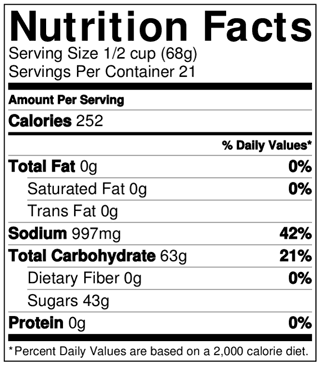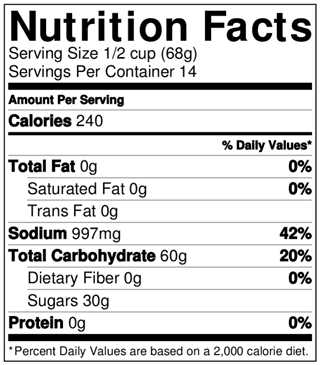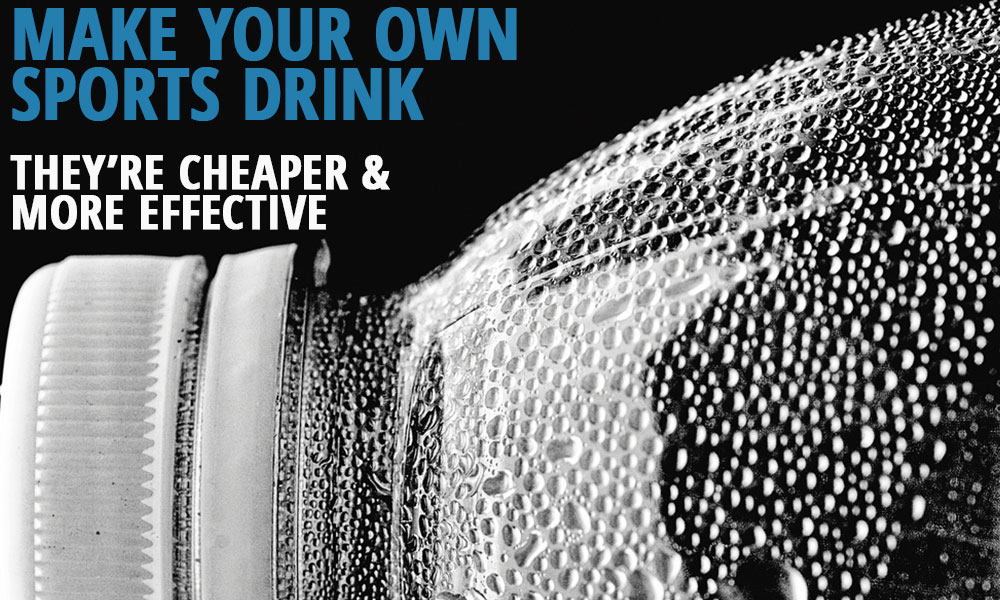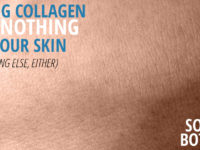I very rarely buy sports drinks—actually, to be honest, I can’t remember the last time. Not only are they incredibly expensive (at about $1 per “serving” and three “servings” per hour it adds up fast), they’re also not superior to anything you can’t easily make at home.
In fact, you can actually make something better—at least so far as sports nutrition is concerned (how it tastes is up to you). Because you have 100% control over what you put in, you can easily tweak and change the formula to suit your individual needs and preferences. Do you dislike intense sweetness when exercising? You can use more maltodextrin (which is neutral in flavor). Want an all glucose drink? You can do that, too. Really, you can do nearly anything just so long as you obey the basic rules of sports drink formulation.
Below, I’ve listed a few “varieties” you can easily make at home along with a section on optional ingredients you can add. Feel free to tweak these recipes, and I’ve even included some tips to make it easier (and more scientifically sound) as well as some “bonus” ingredients you can add.
Basic Variety #1: “The Standard”
Nearly all well-formulated sports drinks use a 2:1 glucose to fructose ratio because it allows for maximum absorption of carbohydrates (60 grams of glucose per hour plus 30 grams of fructose); this homemade sports drink uses this same ratio. This is also the cheapest version since it requires only one hard-to-find ingredient (maltodextrin) and otherwise uses common and cheap kitchen ingredients.
The final osmolality of this beverage is 235 mOsm/L, and the recipe makes twenty-one 63 gram carbohydrate servings. At the time of writing the total cost was $5.01 or $0.24 per serving. Pricing is based off TrueNutrition.com prices and the current USDA estimated retail cost of sugar, but you may be able to find a better deal (especially if you buy in mega-bulk sizes, i.e. 50+ lbs at a time).
Ingredients
- 1 lb Maltodextrin (426 g CHO) $3.69
- 2 lb Table Sugar (907 g CHO) $1.32
- 3 TBS Table Salt
- Flavoring (optional)
Helpful Tools
- Standing Mixer
- Kitchen Scale

Directions
Pour all the ingredients either into the bowl of your standing mixer or a bowl large enough to hand mix in. Thoroughly blend the ingredients together until evenly distributed, then store in an airtight container such as a large ziploc bag.
A serving is a half-cup, weighs approximately 68 grams, and should be mixed with one liter of water to achieve the above-noted tonicity. One serving will provide 63 grams of carbohydrate in a 2:1 glucose to fructose ratio. You can concentrate this beverage by approximately 125%—i.e., mix one serving with 800 milliliters of water—to 79 g carbohydrate/L (for more demanding scenarios or longer days) without the beverage becoming excessively hypertonic (294 mOsm/L).
Tips for Tweaking
Decrease Sweetness/Decrease Fructose
This drink has a lot of table sugar (sucrose) in it and that will make it very sweet, which you may or may not like. The reason there is so much table sugar is that it’s the easiest way (and best way) to achieve a 2:1 glucose to fructose ratio when used alongside maltodextrin (pure glucose), but this ratio is most important when you plan on consuming exactly 90 grams of carbohydrates per hour (the absolute maximum you can absorb hourly). If you want a less sweet drink, and plan on consuming less than 90 g/hour, then you can change the ratio of maltodextrin to table sugar from 1:2 to 1:1 or even 2:1 or less. This will cause the following changes the glucose/fructose content:
| 1:2 | 1:1 | 2:1 | 3:1 | 5:1 | |
| Glucose | 40 g | 45 g | 50 g | 52.5 g | 55 g |
| Fructose | 20 g | 15 g | 10 g | 7.5 g | 5 g |
| Max Carbohydrate per Hour | 90 g | 80 g | 72 g | 69 g | 65 g |
Important Note: If you change the ratio of maltodextrin to table sugar, be sure to keep total hourly carbohydrate intake at or below the amount specified for that specific ratio (the final row of the table above) as you will be unable to absorb more.
Basic Variety #2: 100% Glucose
Climbers are unlikely to need the extra fructose (which increases total carbohydrate absorption by an additional 30 grams per hour)—except during the most intense training sessions or longest days—and may wish to forgo it. This blend uses dextrose (pure glucose) as a sweetener instead of sucrose (which is 50/50 glucose:fructose) and is therefore 100% glucose.
The final osmolality of this beverage is 288 mOsm/L, and the recipe makes fourteen 60 gram carbohydrate servings.
At the time of writing the total cost was $6.48 or $0.46 per serving. All pricing is based off TrueNutrition.com prices, but you may find a better deal (especially if you buy in mega-bulk sizes, i.e. 50+ lbs at a time).
Ingredients
- 1 lb Maltodextrin
- 1 lb Dextrose
- 2 TBS Table Salt
- Flavoring (optional)
Helpful Tools
- Standing Mixer
- Kitchen Scale

Directions
Pour all the ingredients either into the bowl of your standing mixer or a bowl large enough to hand mix in. Thoroughly blend the ingredients together until evenly distributed, then store in an airtight container such as a large ziploc bag.
A serving is a half-cup, weighs approximately 68 grams, and should be mixed with one liter of water. One serving will provide 60 grams of carbohydrate all from glucose. You cannot concentrate this beverage, not only for reasons of tonicity (it would be hypertonic) but also because glucose absorption caps at 60 grams per hour and thus there is no reason to.
Tips for Tweaking
Decrease Sweetness
The main form of this recipe uses a 1:1 maltodextrin to dextrose ratio, which is already much less sweet than Variety #1. If you wish to decrease sweetness further, it’s just a matter of replacing the dextrose (which is mildly sweet) with maltodextrin (which is neutral). Decreasing sweetness in this way decreases tonicity as well, so you don’t need to worry about that.
Increase Sweetness
It’s challenging to increase the sweetness of this recipe because pure glucose (in the form of dextrose) is less sweet than either pure fructose or sucrose (which contains fructose). If you increase the dextrose in the recipe, then it will become hypertonic. The best you can really do is to cut the sodium by 66% and increase the dextrose to maltodextrin ratio to 2:1. This will result in a drink that has per serving 40 grams of dextrose, 20 grams of maltodextrin, and 665 milligrams of sodium. The easiest way to change the recipe is to add a pound of dextrose but otherwise keep it the same, and it will now produce 21 half-cup servings.
Optional Add-Ins
While you only really need some carbohydrates and salt to make an effective sports drink, there are a couple ingredients that you may wish to add.
Citrulline Malate
Citrulline malate has two purposes: first, it could potentially improve blood flow and thereby help reduce the pump; second, it’s delightfully sour and adds a nice flavor to any sports drink. In my opinion, it’s well worth adding for the second reason alone, but the first is potentially useful as well.
You can add citrulline malate to either of the basic formulas above without pushing tonicity into the no-go zone. Depending on how sour you want it, you can measure it out to either add 2, 3, or 4 grams to the final product.
| 2 g In Drink | 3 g In Drink | 4 g In Drink | |
| Citrulline Malate Added to Recipe #1 | 42 g | 63 g | 84 g |
| Citrulline Malate Added to Recipe #2 | 28 g | 42 g | 56 g |
| Increase in Tonicity | 6.5 mOsm/L | 9.75 mOsm/L | 13 mOsm/L |
If you plan on concentrating the beverage, you may wish to add a lesser amount because the citrulline malate will also concentrate, quickly creating a very sour drink.
Whey Protein
If you’re not bringing a protein source to the crag with you, or you’re planning a long and intense day of climbing where you won’t necessarily be thinking about eating normal amounts of regular food, then adding whey protein to your shake is a good way to ensure you still get ample protein. Beyond muscle maintenance, the protein also supplies BCAAs and other amino acids that can support endurance, so it could make a difference if you’re out there long enough.
Whey proteins are extremely large molecules so they have virtually no effect on tonicity—15 grams of whey protein (the recommended amount) in the final product increases tonicity by only 0.7 mOsm/L. Thus, choosing to add this is more about taste and price (whey will add a milky flavor, and the isolate form you want to use is expensive) than concerns about tonicity.
If you do add whey protein to your mix, you would add ¾ lb whey protein isolate to the recipe for Variety #1 or a ½ lb whey protein isolate to the recipe for Variety #2.
You could theoretically add other protein powders instead of whey protein isolate, but the reason I ultimately recommend whey over all others is because:
- It’s highly soluble, so you won’t get clumps or undissolved grainy bits.
- It’s extremely rich in BCAAs, which is the reason you’re using it.
- Despite adding a mild milky taste, it is not an entirely unpleasant flavor.
Other proteins may or may not offer some of these benefits, and no other protein offers them all.
Changing the Sodium Content
The amount of sodium I used in each drink is carefully decided based on the needs of a typical climber, but you may wish to change the sodium content of your drink for whatever reason. If you do decide to change the sodium, however, there are a few things to be aware of:
If Decreasing Sodium…
There is no problem with decreasing sodium as you will only lower the tonicity of the beverage, but you do want to ensure you keep sodium above about 575 milligrams per liter. Given a starting sodium of 997 milligrams per liter (for the final drink), this means I wouldn’t recommend using less than 2 TBS in the whole recipe for Variety #1 or 1 TBS + 1 tsp for Variety #2. In either case, this will decrease the sodium content of the final drink to 665 milligrams per liter.
If Increasing Sodium…
You should not really need to increase sodium since any activities that cause excessive sweating are also benefited by using a concentrated drink, which concentrates the sodium as well. However, if you are a heavy sweater even during typical climbing scenarios and you think you could use extra sodium, then be aware of how the extra salt will affect the beverage’s tonicity. Each 100 mg of sodium adds 8.7 mOsm/L to the final product, so it adds up fast.
In light of this, you cannot both add salt to Variety #1 and concentrate it unless you decrease the ratio of table sugar to maltodextrin (decrease its sweetness), which also affects the maximum amount of carbohydrate it’s capable of providing per hour. Similarly, for Variety #2 you need to increase the ratio of maltodextrin to dextrose or the beverage will become hypertonic.
In either case, you can increase the saltiness, you just need to make sure you’re aware of how you’re changing the tonicity!















Thanks Brian!
This is great. Thank you. One question though – how much water per ½ cup serving?
For the Basic Variety #1, you would mix a 1/2 cup with 1 liter of water for a drink of “normal” concentration, or with 800 milliliters of water to get a 125% concentration. For Basic Variety #2, you would mix it with a liter of water.
Another great resource. Thanks for this. I am going to make my own sports drink following recipe #1 but I would also like to add some free-form amino acids to it (specifically this: http://www.bulknutrients.com.au/products/future-whey.html). Is it safe to assume that the effect of this product on tonicity is similar to whey protein?
It looks like the product you linked to (“Future Whey”) is an essential amino acid blend with a few additional ingredients. Whey’s low osmolality is due to it being a single molecule that doesn’t dissociate in a solution (as sodium chloride would, for example, which dissociates into two units: a sodium ion and a chloride ion). Since the amino acids in the product are not molecularly tied, they would all contribute to the osmolality, which means it would have an osmolality more in line with BCAAs (about 7.85 mOsm/g). With a 25 gram serving size, this would put you at a bit under 200 milliosmoles (if mixed into a liter of water), which is still hypotonic but doesn’t leave a lot of room for anything else, like sodium.
Hi! Great article. I have used option #1 for a while with great results. However I was wondering if, let’s say, in reduction phase is it possible to use only BCAA ? No carbs should be better for me to loose some weight and amino-acids will help me to keep high performance during training – what do you think ?
BCAAs can help fight central fatigue during extended training sessions (3+ hours), at least in endurance athletes; we have less info on strength or power athletes like climbers. It wouldn’t have a strong effect on your performance aside from that, though, as BCAAs (amino acids) are an energy source of last resort and, at any rate, the amount of BCAAs you would supply is likely to be very little (<10 grams). If you feel like you need to avoid carbs to effectively lose weight, you will lose some performance as a result both through the loss of your largest anaerobic energy pool and also the sum loss of available energy through caloric restriction. Your training intensity will likely decrease, but if you shift your training towards aspects that are either shorter in duration (such as power training) or more focused on skills you will probably notice less of an impact.
You can also supply carbs in your drink solely for the purpose of providing an exogenous energy source during exercise and help recover muscle glycogen afterwards. Performance will still decrease (it always does to some extent during weight reduction phases), but you'll maintain a greater amount of your anaerobic power endurance and so it might be preferable. In this way, you'd essentially limit carbs to only the exercise period and otherwise consume whatever weight reduction diet you'd prefer.
Confused with option #1….63 grams of total carbs would not be 60 grams of carbs from glucose and 30 grams of carbs from fructose, the max to be absorbed in a hour. I would think total carbs would be 90 grams (60g glucose and 30g fructose) if following 2:1 glucose/fructose ratio, correct?
I set the serving at a half-cup of mix, or about 68 total grams of mix. In a single serving there are 63 grams of carbs, about 21 coming from maltodextrin and about 42 coming from table sugar for a total of 42 grams glucose and 21 grams fructose (a 2:1 ratio of glucose to fructose). Most people don’t actually need or benefit from 90 grams of carbs per hour, so I wanted to make the recipe more universal with the option of concentrating it some for situations that might call for more carbs, hence the 63 grams serving size.
Great article Brian, I really enjoyed it and found it very informative. I’ve been on the hunt for a good explanation for this and you nailed it. I do a lot of endurance rides, so I like to hit the 60g/carb rule every hour, usually with a combination of drink and food. If I’m understanding this correctly, using Basic Variety #1, I would just add 2 liters of water to the 1/2 Cup of mix and then each liter of drink would contain around 30g of carbs right? Thanks again.
Glad I could help! You are correct, if you add a 1/2 cup of mix to two liters of water you will end up with 30 grams of carbohydrate per liter (or 31.5 grams, to be more accurate).
What are your suggestions for adding flavor?
If you want flavor, your best bet is to buy some flavor packets from a place like TrueNutrition.com. You could also use something like a Nuun tablet, although those will also have other components (electrolytes and vitamins, usually) so they’ll have a greater effect on the final tonicity of a beverage.
How do you calculate the 288 mOsm/L for variety #2? I’m sure I’m missing something. Thanks for the great article.
The 30 g maltodextrin will contribute roughly 34.3 mOsm, the dextrose will contribute 166.5 mOsm, and the table salt (sodium chloride) will contribute the remaining 87. Summing these numbers and rounding to the nearest whole number yields 288 mOsm.
Great article, I am keen to understand the protein addition. Especially if you looking to maximise the protein intake. Looking at recipe 2 and adding protein which normally is 30g protein per scoop. How does this recipe do this ? Also is the 68g serving still the same with this addition.
I also was going to add Citrulline Malate, I read 6g per serving ie. Gym workout …not sure ?
Since protein doesn’t affect osmolality to a great extent thanks to its high molecular weight, you should be able to add in whatever protein you choose without significantly raising the final osmolality. No special instructions are necessary ton prepare it, you would simply add the protein to mix and add the same amount of water. With the citrulline malate, you may want to decrease the dextrose a touch to ensure the drink doesn’t become hypertonic. If you sub out 0.25 lb dextrose for 84 g citrulline malate, you should end up with an isotonic drink that still provides a little over 50 g of glucose per serving.
Hi, this is a great article, thank you. I am interested in trying Variety #2 but would like to try adding baking soda and citric acid for some effervescence (will create sodium citrate I believe). If I were to add 3g each of sodium bicarbonate and citric acid per litre of water, can you please let me know what adjustments need to be made to the existing recipe to avoid hypertonicity?
Hi Mark, sorry it took so long to get back to you on this. Sodium bicarbonate has a molar mass of roughly 84 g/mol, so 3 grams would be 0.0357 moles or 35.7 millimoles; however, since sodium bicarbonate (NaHCO3will fully dissociate into Na+ and HCO3–in solution, it will contribute doubly to the overall osmolarity of the solution and actually yield 71.4 milliosmoles. Citric acid is roughly 192 g/mol and will not significantly dissociate, so the total osmolarity of 3 g citric acid would be around 15.6 milliosmoles. Thus, adding both together would contribute about an extra 87 milliosmoles to whatever solution (per liter) you added them to. To avoid hypertonicity, you would need to remove enough other ingredients (salt would no longer be as necessary, for example, since you have sodium in the NaHCO3) to keep it around that 300 milliosmole mark. Hope that helps!
Thinking about adding straight fructose powder rather than sugar. Still follow the 2:1 glucose/fructose recipe, and 1/2 of this mixture to 1L water? Also my current sports drink includes electrolytes (sodium, potassium, magnesium). Worth adding these as well? For reference I am a competitive cyclist and currently use Cytomax.
That would likely be fine, but it will increase the osmolality of the solution since sucrose has half the osmolality of an equivalent amount of pure glucose and fructose. Sodium is the main electrolyte worth adding to any sports drink as we simply don’t lose enough potassium or magnesium through our sweat to justify replacing them in our drink.